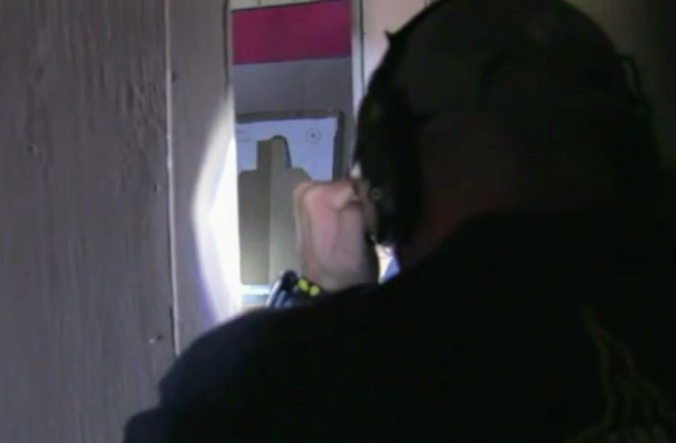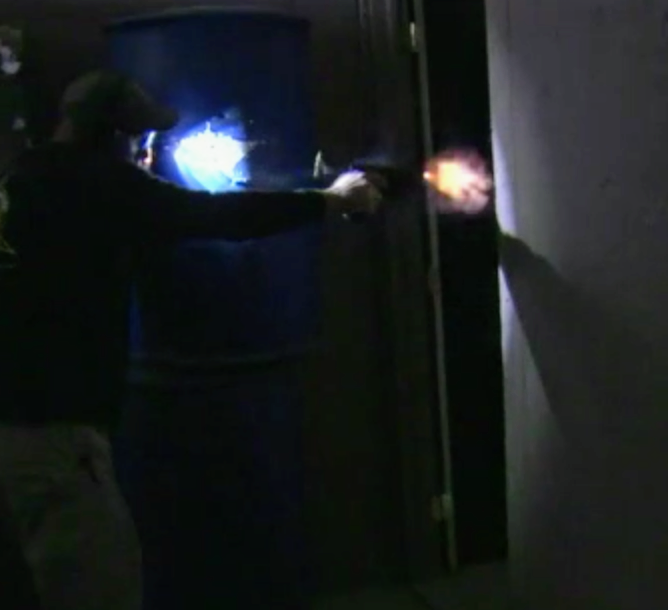
There’s a reason the term “shot in the dark” doesn’t mean “to do something with great clarity.” (Michael Connick photo)
Michael Connick recently completed a nighttime match with the International Defense Pistol Association (IDPA). This resulted in some interesting insights for using handguns in dark or low-light conditions that fiction writers might find illuminating. His guest post is below. Enjoy!
~Ben

Michael Connick is the author of “Trapped in a House of Mirrors” and “Funhouse Mirrors.” Both are available at all fine book retailers. (Image courtesy of the author)
According the National Criminal Justice Reference Service of the US Department of Justice , about 90% of police shootings happen in low-light conditions.
Bad things done by bad people tend to occur in the dark. If your protagonist needs to go after some evil-doer at night or in a darkened building, they are going to need to be able to see threats well enough to accurately engage them with their handgun. They are going to need to be familiar with the techniques required to manage lights and handguns in the dark.
This article is going to discuss some of these techniques.
Using a Weapon-Mounted Light: Easier to See, but Harder to be Safe
I’ve had multiple training courses in low-light and no-light shooting. One course I attended was held in a building that was so dark that you could not see your hand in front of your face.
This course used weapon-mounted lights on Glock 17 service pistols, which were loaded with simunitions (low-velocity handgun rounds with soft plastic bullets that leave a colored mark where they hit). It really hurts to be shot with one, so participants wear protective gear, and even so, still feel the sting of being hit. Below is a picture of a Glock 17 pistol with weapon-mounted light, similar to what we used during the course.
What I learned in this course about using a weapon-mounted light is that they were great for illuminating a bad guy, but not so great for searching for one. The problem with trying to use a weapon-mounted light as a flashlight is that you end up pointing the gun at everything you are looking at, including possible innocent bystanders. This is never a good idea.
In addition, since the light is mounted on the bottom of the handgun, the sights of the Glock were hard to see clearly, and so it was difficult to accurately shoot the gun at anything beyond a fairly close range. Frankly, given the extra bulk and weight of the light, and all its disadvantages, I wasn’t all that impressed by the usefulness of this type of illumination device.
Using a Flashlight with a Handgun: Harries and FBI Techniques
Another training class I took was a live-fire course in night shooting using flashlights. During this course I trained using two different flashlight techniques: Harries and FBI.
The Harries Technique
With the Harries technique (assuming you’re right-handed), the handgun is in your right hand and the flashlight in held like an ice pick in the left hand, as shown in the picture below. This technique, along with all of the following techniques, requires a flashlight with an end cap button capable of turning it on.
This is one of the older techniques around for using a flashlight and handgun together. It was created by Michael Harries in the 1970s. The advantage of this technique is that you end up with two hands stabilizing the gun.
One disadvantage of this technique is that your gun’s sights aren’t illuminated, so the gun is harder to aim in the dark. Also, you end up pointing the gun wherever you are pointing the light, just like a weapon-mounted light, potentially endangering innocent bystanders.
The FBI Technique
The FBI technique, shown in the picture below, separates the hands and moves the flashlight high up and away from the body.

This techniques offers a couple of advantages over Harries. The first is that since the light and gun are no longer coupled, you can now move the light around when searching without having to point the gun where you are looking. Also, peripheral light from the flashlight will at least partially illuminate the handgun sights, making the handgun easier to aim.
An additional theoretical advantage of this technique is that the light is away from your body. If an opponent shoots at the light, they won’t hit your body. However, flashlights in a darkened space are extraordinarily brilliant to look at, and records of actual shootings where flashlights have been used simply don’t show any cases of this actually happening.
The final disadvantage of the FBI technique is that it can be quite fatiguing to hold a flashlight like this during a long search.
A New Flashlight Technique
Mike Seeklander is a well known IDPA champion and firearms trainer. I recently learned a new flashlight technique from him. He calls it the Eye Index technique. I call it the Temple Index technique, because I think this is a more accurate name for how the flashlight is actually held.
Regardless of what it’s called, it looked to me like a great technique to use, but I hadn’t had a chance to actually try it out. That is, right up until my nighttime IDPA match. I finally got to try it out there. The picture below shows Mike demonstrating how the light should be held, again, like an ice pick, but now right up against the temple, with the gun being held in the other hand.

The advantages of this technique are many. First of all, the light is in a position to illuminate the handgun’s sights extremely well, while still illuminating the target, and without throwing the shadow of the gun onto the target.
Next, the light automatically points towards wherever you happen to be looking. Turn your head left, the light points there. Look down, the light points there.
Finally, holding the light against the temple is much less fatiguing than the FBI technique during long searches. All of these advantages made it seem like the perfect technique for me to try out.
I tried it during the nighttime match, and it worked just as well as I thought it would. I was able to shoot quickly and accurately with my sights brilliantly illuminated and the targets clearly in view. I even shot the “Lights Out” stage of the match cleanly. Every shot made on the stage was perfectly on target.
Mind the Batteries
Don’t let the protagonist leave the flashlight on the entire time he is using it to search. It’s best to turn on the light, look around, then turn if off, move some distance, and then repeat the cycle. That makes it much harder for their adversary to locate them and get a lucky shot off in their direction.
That’s exactly what I practiced during the IDPA match. I illuminated each room, engaged the appropriate targets, turned off my light and ran over to the next room. Make sure your beloved character does something similar to maximize their chances for survival.
Is Muzzle Flash an Issue?
People sometimes worry about muzzle flash. Below is another picture of Mike Seeklander using the Temple Index technique and shooting his handgun in a darkened live-fire shoothouse.

Notice how bright the muzzle flash is – it looks like it might be blinding to the shooter. However, it’s been my experience that in the excitement of shooting you don’t even notice it, and it’s never seemed to hinder my ability to shoot well in the dark.
But What About Night Sights?
Some of you readers who are familiar with handguns may be asking yourself why I haven’t mentioned night sights in this article. These consist of tubes placed into the sights that are filled with tritium and glow in the dark.
The short answer is that I have tested them extensively and just don’t like them. Exactly why I don’t would take an entirely new article on handgun sight design, which I may write someday for this site. For now, just be aware that I haven’t forgotten about them, I simply choose not to use them on any of my “fighting” guns – the concealed handguns I carry on a daily basis for the defense of myself and my loved ones. In any case, when using the Temple Index technique, I certainly don’t need them.
I hope you find all the above information to be useful in helping your protagonist deal with villains who may be lurking in the dark!
About Michael Connick

Connick’s books are available at Amazon, Barnes & Noble and all other fine book retailers. (Image provided by the author)
Michael Connick has had a long career with the intelligence community, the Department of Defense, and the technology industry. He has also carried a concealed handgun for over 35 years, and participated in extensive firearms and self-defense training from governmental, law enforcement, and private organizations.
He now resides in the little college town of Huntington, West Virginia, where he writes, competes in Practical Pistol and Rifle competitions, and is very happily married to a truly wonderful wife. He is the author of two Cold War spy novels, Trapped in a Hall of Mirrors: How The Luckiest Man in the World Became a Spy and Funhouse Mirrors. More information can be found about Connick at http://michaelconnick.com.


Thanks, Ben, for this helpful information. 🙂 — Suzanne
LikeLiked by 1 person
Thanks for stopping by!
LikeLiked by 1 person
I’m so glad you mentioned the mounted lights are not good for searching for suspects, Michael. When writing a scene not long ago, I came to the same conclusion, but of course, without ever using a light clipped to a weapon, it was more of an educated guess. Thank God I was right! The book just released. Imagine my surprise had you said it was the optimal way to search for a suspect? Yikes.
Hi, Ben! Hope you had a nice Easter.
LikeLiked by 2 people
I hope you did, too! I was just speaking your praises to Fiona Quinn.
LikeLiked by 1 person
Aww… (pay you later LOL)
LikeLike
Pingback: Characters Shooting in the Dark: What Writers Should Know – Michael Connick
Great information Ben! In fact, my latest novel I’m finishing up has a nighttime sequence 🙂
LikeLiked by 1 person
Reblogged this on Bum's Landing & Restart – Andrè Michael Pietroschek.
LikeLike
Good job, both, Michael and Ben!
LikeLike
http://site.pelgranepress.com/index.php/category/products/nights-black-agents-products/
My kind of focus…
LikeLike
Wow! How knowledgeable you are on this subject.
LikeLiked by 1 person